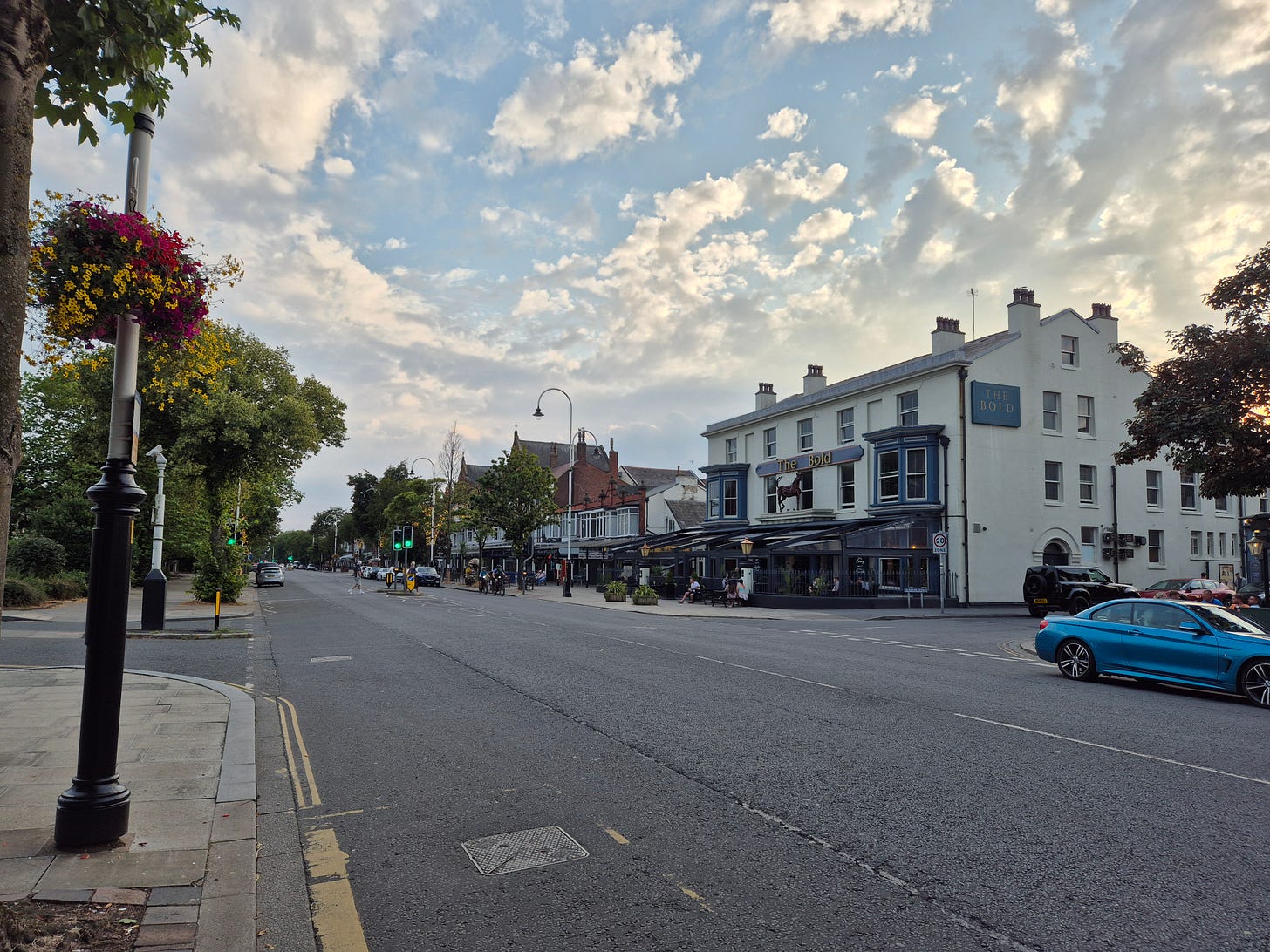Will Southport 'tourism tax' fund needed services or put off investors?
Plus: Town's continued rail woes raised in Parliament and our pick of what's on and things to do for the week ahead
Hello and welcome to the 21st edition of The Southport Lead.
Today’s main story takes a look at a proposed tax which could affect some businesses setting up - or extending their premises - in Southport. The proposal is similar in philosophy to the tourism tax seen in many European cities which creates a dedicated fund for the services most affected by visitors.
It is one of the ways some people believe local authorities can maintain services despite long-running budget cuts from and rising costs but Sefton Council’s plan is already facing warnings that businesses could be put off.
Also in today’s edition, there’s more from Southport MP Patrick Hurley on the public transport issues facing the town and, for paid subscribers only, your What’s On guide to the week ahead from Stand Up For Southport’s Andrew Brown.
Warnings over Southport ‘tourism tax’ plan amid fears investors will be put off
Plans for Sefton Council to raise additional funds by taxing tourism-related developments have been greeted by warnings from opposition councillors.
A report by the council’s chief planning officer Derek McKenzie recommends the introduction of a ‘Developer Contributions to Southport Visitor Infrastructure’ policy which would mean some new businesses pay into a fund dedicated to local improvements.
The idea behind the plan is to use tourism-related income to directly fund the infrastructure which supports this element of the economy. For example, through maintenance of parks and to help keep the town clean and attractive.
The idea is similar in some regards to the tourism tax policy which is common in many European cities and sees hotel users pay a small levy each night to fund local services and infrastructure. This is a policy Greater Manchester Mayor Andy Burnham hopes to implement in his area to help its promotion and upkeep.
Explaining the need for the proposed new levy, Mr McKenzie said: “Southport is Sefton’s key Tourism and Visitor location. Tourism generates a significant amount of jobs and investment in the town but also puts huge strain on its infrastructure, much of which is managed by the council.
“Therefore, it is considered appropriate that development which benefits from investment in and the upkeep of infrastructure that supports the tourism and visitor economy, contributes to it.”
He continued: “As a result of the high number of visitors, the council-maintained visitor infrastructure in Southport is put under huge pressure due to ‘wear and tear’ through intensive use. The maintenance of this infrastructure is necessary to support the tourism industry. However, at a time of stretched council budgets, infrastructure cannot always be repaired or maintained to the level the council would ideally like.
“The council are therefore exploring a number of ways to secure additional funding to contribute to the ongoing maintenance of existing, and provision of new, visitor infrastructure.”
Mr McKenzie argues that as new businesses benefit from investment in the visitor infrastructure, it is ‘considered justified to require them to make a proportionate contribution to that infrastructure’.
The plans are only proposals at this stage but if the levy was implemented as currently suggested, it would involve a tax of £2,680 per 100m2 of new or converted floorspace whenever planning permission was granted. Existing businesses and new ones which did not require changes to planning permission would not be affected.
The funds would then be used towards projects including park maintenance, public toilets, public realm improvements, car parking facilities, Southport Pier, public information boards, and public artwork.
A consultation would be needed before any such changes can be introduced but warnings have already been made against them.
Cllr John Pugh, the Liberal Democrat group leader and former MP, warned that it could actually deter business people from wanting to set up in the town.
He said: “It may in practice act as an incentive for businesses to ignore or disinvest in the town centre and go to Birkdale, Ainsdale and Churchtown where there is no such levy. Southport town centre businesses on top of rates already pay an additional levy to the Southport BID and currently are living on very fine margins.
“I think we need to see some evidence that this kind of strategy has actually worked to revive declining town centres. Policy needs to be evidence led. Taxing investment does not normally encourage investment and the town centre needs investment.”
Cllr Pugh also warned there needed to be assurances that the funding raised from such a tax would add to existing budgets for these services rather than replacing them to be used elsewhere.
He added: “I do not doubt the ‘good intentions’ of Sefton Council but am worried about real world impacts and urge caution. The council is one month trumpeting the fact that with government money it is temporarily reducing the rates for a hard-pressed leisure and retail sector and next month assuming they are doing well enough to cope with an extra charge when they extend or convert their premises.
“One month they are encouraging owners to convert shops to homes; next month they are threatening to tax them for doing so. It does not look like a joined up strategy”
Cllr Mike Prendergast, the Conservative group leader, made similar warnings that investors could be put off while describing it as a “Southport Investment Tax”.
He said: “Southport relies heavily on its tourism, hospitality and leisure sectors and they are already grappling with increases in the minimum wage and massive increases in National Insurance by the Labour national government. At a local level, local businesses already pay their Business Rates and many in the town centre pay more to contribute to Southport BID. Car parking charges are high and Labour in Sefton have flatly refused to review these.”
“Local businesses are already suffering; Labour can’t just keep squeezing them for more money, locally as well as nationally, you can’t tax your way to growth. These proposals should have been rejected by Sefton Labour but instead, once again, Southport is being used as a cash cow.”
The uncertainty of the finer details is evidenced in the warnings against it. While Cllr Pugh’s says it risks pushing investment into the villages, Cllr Prendergast highlights a point that hotels outside of the Southport Central Area and Southport Seafront, area would also be impacted. As a result, he argues, the chances of Ainsdale-by-the-sea receiving much needed investment could be hampered.
He said: “Outside of the town centre, this will also catch other potential development. In Ainsdale, we want to see the area around The Sands and Pontins improved, the likelihood of that incorporating any kind of new hotel or holiday accommodation is now reduced because of this new tax.”
“This latest tax on Southport needs to be dropped and we need policies that encourage investment, not drive it away. Southport is a wonderful place to live, work and visit and we could make it so much better if we create the environment for businesses to thrive and draw people in.”
Councillor Daren Veidman, Cabinet Member for Housing and Highways, told The Southport Lead: “As investment is secured in Southport through local and national initiatives, we are expecting to see an increase in visitors and tourists into the town. This will give huge boost to the local economy but will also bring with it challenges.
“The pressure that increased visitors place on much needed public infrastructure that supports the tourism economy will require additional funding to provide, maintain and replace it. It is only fair that those major new developments that directly benefit from that infrastructure contribute a small share of those costs, and do not all fall on local residents.
“The proposed developer charge is an innovative way to secure contributions that will be ring fenced for local visitor infrastructure. This proposal is only one route of many the council is considering to secure funding towards Southport’s visitor infrastructure.
“The proposed development charge is set out in a draft Supplementary Planning Document which will be made available for public and stakeholder comment. This will give everyone, including residents and businesses, a chance to have their say if this approach is necessary and suitable. The council will take on board comments when deciding whether to proceed with the developer charge or not.”
71 minutes, three train changes and a £21 ticket to travel 10 miles
In Wednesday’s edition of this newsletter, Southport MP Patrick Hurley spoke of his frustrations with Northern Rail and its continued poor service connecting the town with Manchester.
Later that day, he was among the long line of Northern MPs who took the chance to speak out about such issues at a Westminster debate entitled ‘Transport Connectivity: North-west England’.
Among the issues raised were the difficulties in using transport to travel from one side of the constituency to the other; unreliable train services; and the long-running missed opportunity to reinstate the Burscough Curves. There was also, however, some cause for optimism.
You can read the full text here:
I will lay out my case in simple terms: north-west public transport is not up to scratch. Specifically, our railway journeys are nowhere near good enough. They are holding our region’s economy back, and we need change. Take my constituency, for instance: there is no direct public transport link from one side of the constituency to the other, despite it being overwhelmingly urban. Try to take public transport from Birkdale to Rufford - a journey of 10 miles - and a single ticket will cost £21, while the journey will take one hour and 11 minutes and involve changing trains three times. It is literally 10 miles away; it would almost be quicker to walk.
Even the rail services that we do have are incredibly unreliable. Just this morning, at 6.47 am, Merseyrail sent out a message on social media saying:
“Due to a train fault, some services on the Southport line face cancellations”.
The first reply said:
“Another day, another train fault”.
The second reply blamed the politicians.
The service to Manchester is even worse: in November, there were no services at all on Sundays for three weeks in a row, and more than a quarter of all journeys were either delayed or cancelled. When the trains do turn up, passengers are greeted with what the chief exec of Northern Rail has called
“some of the worst-performing rolling stock in the country.”
That cannot be allowed to continue.
The constituency’s connectivity has also been directly impacted by the well-known 1960s cuts to railway services. The closure of two simple railway curves in Burscough, just outside of constituency, means that the seven-mile journey from Ormskirk to Southport takes 85 minutes by train, and that the notional 20-mile journey to Preston involves passengers changing at Wigan, which is itself 20 miles out of the way.
We are lucky, though, because unlike in other parts of the country, the railway curves at Burscough were never built over—they are still there, just overgrown and unloved. It would cost an estimated £30 million to reinstate them, which would once again connect the towns of Merseyside and west Lancashire, and strengthen travel-to-work routes, promoting the economic growth we all want so desperately.
It is not all bad. The Liverpool city region combined authority is maintaining the £2 bus fare cap, including in Southport, and we are moving forward with trials of bus franchising across the region.
Despite problems, Merseyrail still received the second highest overall customer satisfaction levels nationally in the latest surveys. And although there is perhaps an element of empire-building, I welcome the fact that our line to Manchester is set to be brought into the Greater Manchester Bee network in 2028, which will finally allow a tap-in, tap-out ticketing system, integrating with Manchester’s.
Those positives point the way forward, as more devolution on transport and greater statutory powers for the coming Lancashire combined county authority ensure that the rest of the north-west is linked up, in the way my constituency already is.
News in headlines
Southport Pier and other tourism infrastructure to enjoy boost from new businesses investing in town (Stand Up For Southport)
Man jailed after police made a discovery during Southport stop and search (LancsLive)
Brave police officer who faced harrowing duty was under attack by thug within hours (Liverpool Echo)
Many thanks for reading this latest edition of The Southport Lead. If you haven’t already, please do sign our petition to Save Southport Pier and also spread the word about The Southport Lead too.
If you have something you think we should know about we’re on southport@thelead.uk and now to our what’s on feature, which is only for paid subscribers. So if you can please consider a paid subscription by tapping below to receive Andrew Brown’s guide each week and help support us to bring The Southport Lead to your inbox every Wednesday and Sunday too.
What’s on this week
By Andrew Brown
There’s plenty of entertainment to enjoy in Southport this week (16th March 2025 - 23rd March 2025) with some superb singers, including Britain’s Got Talent star Tom Ball and an award-winning Adele Tribute starring Natalie Black.
You can also enjoy great comedy with a Comedy Bingo Winter Social at Southport Market and Comedy Gold at Southport Bijou Cinema, while Southport Little Theatre hosts Private Lives – a comedy of manners by Noel Coward.
Keep reading with a 7-day free trial
Subscribe to The Southport Lead to keep reading this post and get 7 days of free access to the full post archives.






